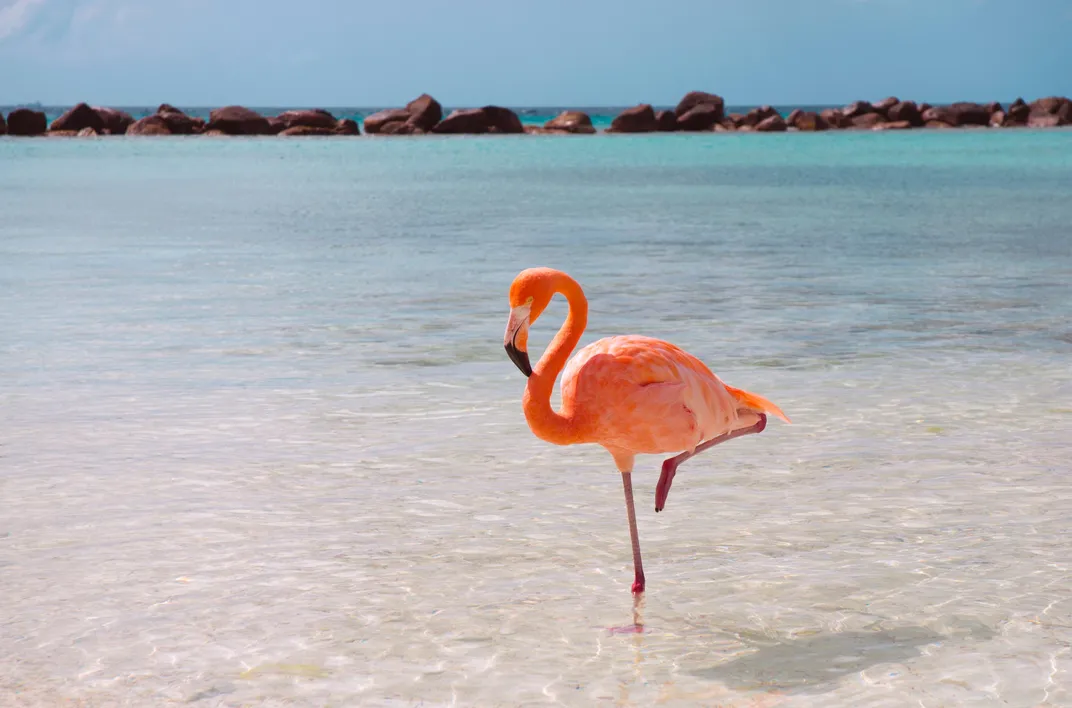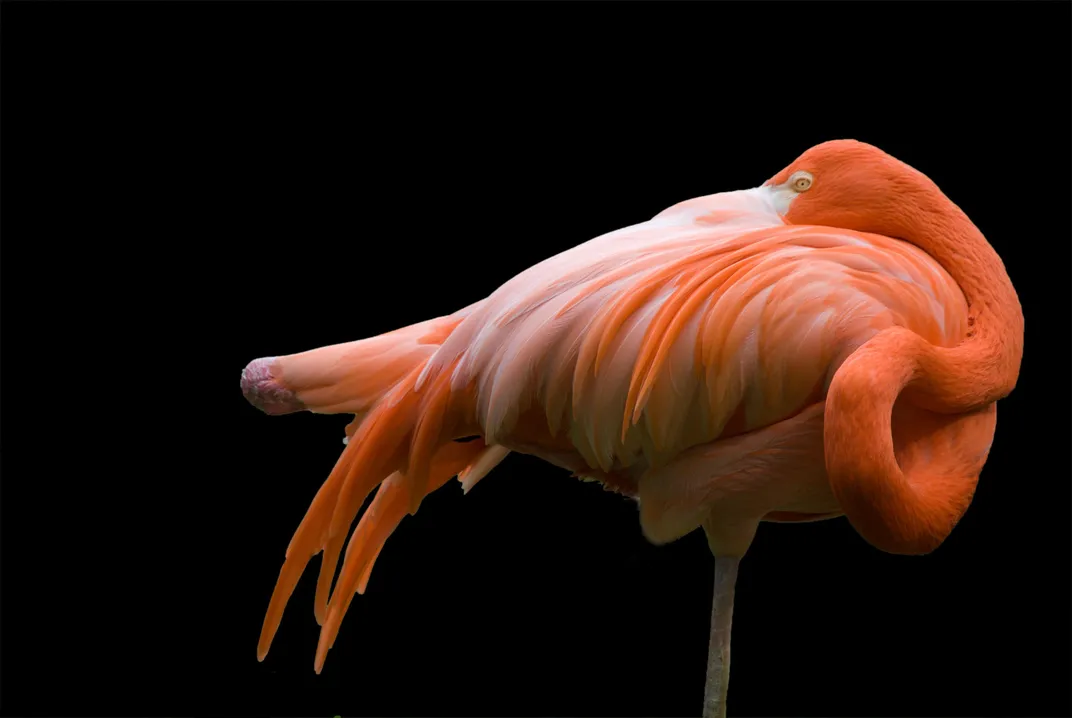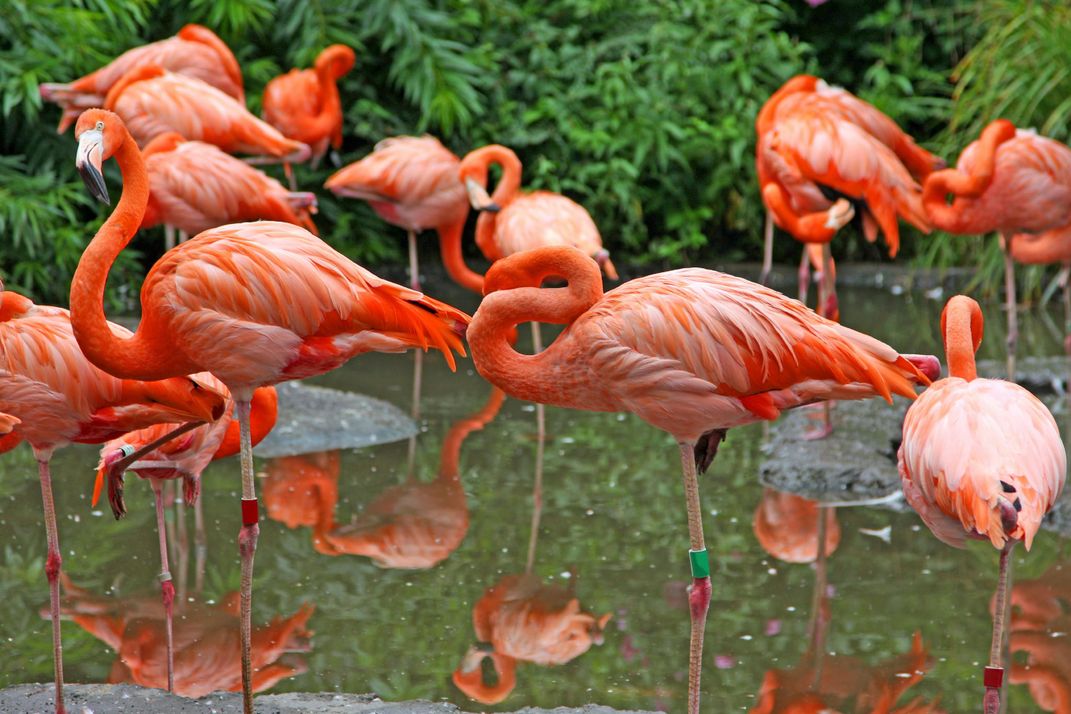Ask Smithsonian: Why Do Flamingos Stand on One Leg?
Flamingos may be doing their one-legged tree pose to stay warm or just because it’s comfortable
Anderson reported that flamingos didn’t seem to be choosy about their resting leg, but that one-legged resting was much more common in the water than on dry land—at least in the Caribbean birds at the Philadelphia Zoo.
Flamingos are social, strikingly colored, and known for a habit of standing on one leg, whether it’s in the wild or as part of a yard-art display.
The reason for this balancing feat—which can last for hours even in the face of high winds—is still being debated, sort of. Until six years ago, the explanation was almost always that it was just more comfortable. But theories are not plentiful, given the small number of scientists who have actually studied flamingo behavior. One—experimental psychologist Matthew J. Anderson—has made a mini-career out of trying to explain why the iconic birds do what they do.
A 2009 study by Anderson has increasingly been accepted as the conventional wisdom—especially by zookeepers, who are frequently queried about the one-legged stance.
Anderson and his colleagues at St. Joseph’s University in Philadelphia have published numerous studies on their observations of Caribbean flamingos (Phoenicopterus ruber) at the Philadelphia Zoo and on other flamingo species in captivity and in the wild. They started watching the flocks to try to figure out if flamingos had a particular right or left preference when craning their necks to rest their heads on their backs. The scientists thought that the preference might extend to which leg they stand on.

Flamingos spend a lot of time partially immersed as they live, feed and breed in lagoons or other large bodies of shallow water. Six species of flamingos can be found around the world, in South America, Africa, the Middle East and the Caribbean.
They tend to favor extremely salty water that would be caustic to most human or animal skin, but that’s never been put forward as the reason for standing on one leg.
“Flamingos are able to tolerate these harsh conditions,” says Sara Hallager, curator of birds at the Smithsonian’s National Zoo. She notes that some flamingos are found high in the Andes, braving blowing snow and freezing temperatures.
According to Anderson, flamingos pull one leg up close to their body to conserve heat that might otherwise be lost while standing in cold water—not just in the Andes, but in the tropics, too, where even a slight drop in water temperature could mean big losses, due to the length of a flamingo leg.

But in another study, New Zealand scientists observing flamingos and other wading birds found that water temperature didn’t seem to make a difference. Instead, they said, it appears that flamingos share a primitive feature also seen in whales and dolphins: the ability to shut down half the brain while sleeping. That keeps the underwater animals from drowning while asleep.
As flamingos go into this half-awake state, “the natural reflex may be for one leg to be lifted towards the body as if it were gently lowering the body onto the ground,” said the scientists, who further reported that the posture is likely an automatic response to getting drowsy. And, standing on one leg would keep them from falling over and drowning, because flamingos—unlike ducks, for instance—have a build that lets them easily stand on one leg without losing their balance or having to harshly angle their knee or ankle joints.
Being half-awake also allows them to stay vigilant for predators.
Hallager says it may all be overthinking—or, that at the very least, scientists have a lot more studies to go before they can say the issue is settled.
“There’s really no good explanation,” she says. “We think that simply it’s more comfortable,” says Hallager.
It's your turn to Ask Smithsonian.


Pink Flamingos All Around
/https://tf-cmsv2-smithsonianmag-media.s3.amazonaws.com/accounts/headshot/AliciaAult_1.png)
/https://tf-cmsv2-smithsonianmag-media.s3.amazonaws.com/accounts/headshot/AliciaAult_1.png)